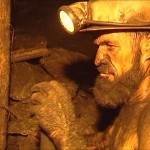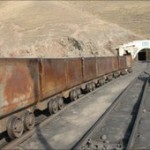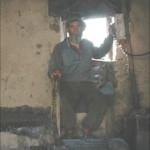All’interno di una miniera di carbone afghana che si sta sgretolando
 Inside a crumbling Afghan coal mine
Inside a crumbling Afghan coal mine
By Quentin Sommerville
BBC News, Pul-e Khumri, northern Afghanistan
The coal wagon rattles along, descending sharply under the hills of Pul-e Khumri, deep into the mine.
At about 100m (328ft) down, the tunnel narrows and it is striking how primitive it all looks.
The roof is held up by bent and twisted wooden stakes which look like they were put in many hundreds of years ago rather than 60 years ago, when the mine was first dug.
It was the Soviets who first discovered Afghanistan’s huge mineral wealth: coal, gold, silver, iron and copper ore, and more besides.
Little safety
More recent surveys say it could be worth trillions of dollars.
Mine at Pul-e Khumri Afghanistan has vast mineral resources
But decades of war mean that these vast natural resources have hardly been touched.
And in the Pul-e Khumri coal mine, nothing much has changed since the Soviets left.
Down inside the mine, at 300m below the hills, the miners scrape the coal from the rock, and fill the wagons.
Except for a ventilation fan there is no mechanical or electrical equipment. And there’s little safety gear either – everybody is absolutely filthy.
The air is cool, until the shaft takes a turn, then the heat becomes intense.
It is very hard, physical, work but there is no shortage of coal. It glistens in the wall, at times it pours from the rock face.
 ‘Dig by hand’
‘Dig by hand’
But Afghanistan has neither the means nor the money to get it out of the ground.
Standing in the gloom, the air is thick with coal dust, one miner, breathing heavily, said: “I’ve been working here for the last 12 years. I work by hand. We push the carts by hand and you can see that we even dig by hand.”
The half dozen workers here have it tough. They are bare-footed and stripped to the waist as they hack at the seams with pick axes.
The coal is a fine powder, and the dust covers them, blackening their teeth and covering their bodies.
“Things were better during the 1980s,” explained another man.
“We had wood. We had equipment. Now we don’t have anything, and what we do have, doesn’t work. We have nothing,” he said.
Nothing that is, except huge mineral wealth, which Afghanistan’s neighbours, and the rest the world, want to get their hands on.
It is upon exiting the mine, stepping into the bright sunshine, that the problems confronting those wishing to exploit Afghanistan’s mineral wealth become blindingly obvious.
The mine is in the middle of a desert. For miles and miles around there are barren hills and barely any roads. Certainly no paved roads reach the mine.
 And, on the other side of the hills, are the Taliban. Potential investors in the mine have been to scared to visit. And there are other worries too. Afghanistan’s deep and widespread corruption means its people may not benefit from its natural riches.
And, on the other side of the hills, are the Taliban. Potential investors in the mine have been to scared to visit. And there are other worries too. Afghanistan’s deep and widespread corruption means its people may not benefit from its natural riches.
“There’s evidence of corruption already,” says political analyst and parliamentary candidate Haroun Mir.
“The [contract for] the biggest copper mine in the region was awarded without transparency.
“There are other small mines too that were awarded to people linked to political power in Afghanistan.
“Business and politics in Afghanistan, are interlinked, you cannot become a successful businessman if you are not involved in political power,” he said.
At the mine, the men bring more coal to the surface, straining as they push the heavy iron wagons full of coal.
At the end of the narrow gauge rail line, the wagon is tipped, and the coal falls to a huge black pile in the sand.
It has been back-breaking work for the miners to get it this far – but given the challenges facing Afghanistan, this may have been the easy part.

Lascia un commento